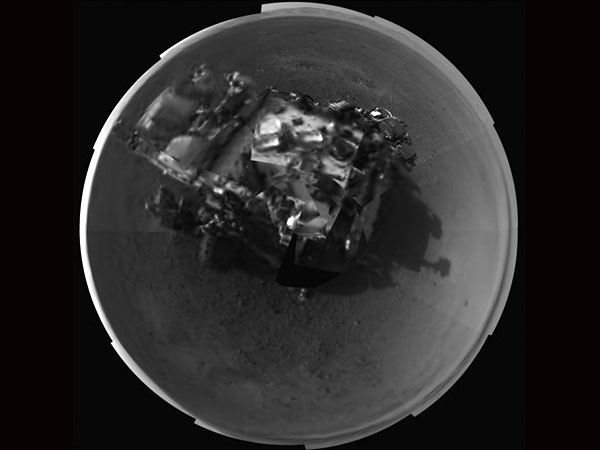Curiosity sends postcards from edges of Mars

In this image released by NASA on Wednesday, Aug. 8, 2012, a self portrait of NASA’s Curiosity rover was taken by its Navigation cameras, located on the now-upright mast. The camera snapped pictures 360-degrees around the rover. (AP Photo/NASA)
PASADENA, California—The science rover Curiosity took a break from instrument checks on its third full day on Mars to beam back more pictures from the Red Planet, including its first self-portrait and a 360-degree color view of its home in Gale Crater.
The panoramic mosaic, comprising 130 separate images that Curiosity captured with its newly activated navigation cameras, shows a rust-colored, pebble-strewn expanse stretching to a wall of the crater’s rim in one direction and a tall mound of layered rock in another, the National Aeronautics and Space Administration (Nasa) said on Thursday.
That formation, named Mt. Sharp, stands at the center of the vast, ancient impact crater and several miles from where Curiosity touched down at the end of an eight-month voyage across 566 million kilometers of space.
Mars’ geologic history
The layers of exposed rock are thought to hold a wealth of Mars’ geologic history, making it the main target of exploration for scientists who will use the rover to seek evidence of whether the planet most similar to Earth might now harbor or once may have hosted key ingredients for microbial life.
But mission controllers at the Jet Propulsion Laboratory near Los Angeles are exercising caution immediately following Curiosity’s jarring, death-defying descent to the surface on Sunday night.
They plan to spend weeks putting the nuclear-powered, six-wheeled rover and its sophisticated array of instruments through a painstaking series of “health” checks before embarking on the thrust of their science mission in earnest.
The $2.5-billion Curiosity project, formally named the Mars Science Laboratory, is Nasa’s first astrobiology mission since the Viking probes of the 1970s and is touted as the first fully equipped mobile geochemistry lab ever sent to a distant world.
After three full days on the Red Planet, “Curiosity continues to behave flawlessly” and has “executed all planned activities” without a hitch, mission manager Michael Watkins said.
Equipment checks
The latest round of equipment checks included an instrument designed to determine mineral composition of powdered rock and soil samples; one to analyze soil and atmospheric samples for organic compounds; one to detect traces of water locked in shallow mineral deposits; and another that uses particle X-rays to identify chemical elements in rocks and soils.
Like Mojave Desert
The very delivery of Curiosity to the surface of Mars already has been hailed by Nasa as the greatest feat of robotic space flight.
The car-sized rover, which flew from Earth encased in a protective capsule, blasted into the Martian sky at hypersonic speed and landed safely seven minutes later after an elaborate, daredevil descent combining a giant parachute with a rocket-pack that lowered the rover to the Martian surface on a tether.
Since then, the rover has been sending a string of early images back to Earth, relayed by two Nasa satellites orbiting Mars, providing glimpses of a terrain that scientists say appear reminiscent of the Mojave Desert in Southern California.
Dark pebbles
One shot beamed back Wednesday night, the first taken by Curiosity of itself, shows the rover’s top deck strewn with dark pebbles apparently kicked up from the ground when the craft landed. Nasa scientists said the gravel does not appear to pose any risk to instruments on the vehicle.
Two separate high-resolution “Navcam” images taken of the surface show that thrust from the sky-crane rockets during descent carved out a 0.5-meter trench in the surface, exposing what appears to be Martian bedrock underneath.
When Curiosity wakes up for its fourth day on Mars early Friday (California time), mission controllers plan to conduct additional instrument checks and prepare the craft for an upgrade of its main computer software for surface operations.
All other activities will be suspended during that upgrade, which will begin on day 5 of the mission and last four days.
Future missions
“It’s very exciting to think about getting there, but it is quite a ways away,” said mission scientist Dawn Sumner.
During its two-year mission, the roaming laboratory will analyze rocks and soil in search of the chemical building blocks of life, and determine whether there were habitable conditions where microbes could thrive.
As high-tech as Curiosity is, it can’t directly look for past or present life; future missions would be needed to answer that question.
Curiosity is the most complex interplanetary rover ever designed, and engineers are taking their time performing health checkups. The rover will not make its first drive or move its robotic arm for weeks. With a report from Reuters